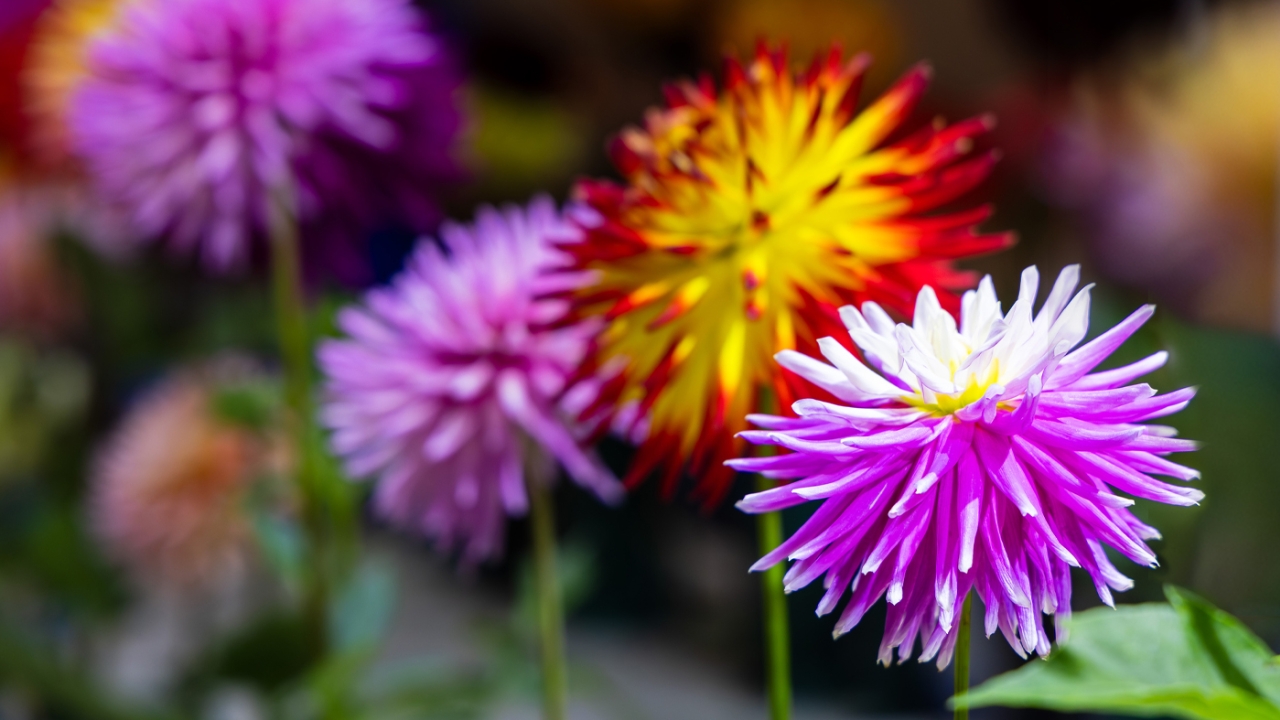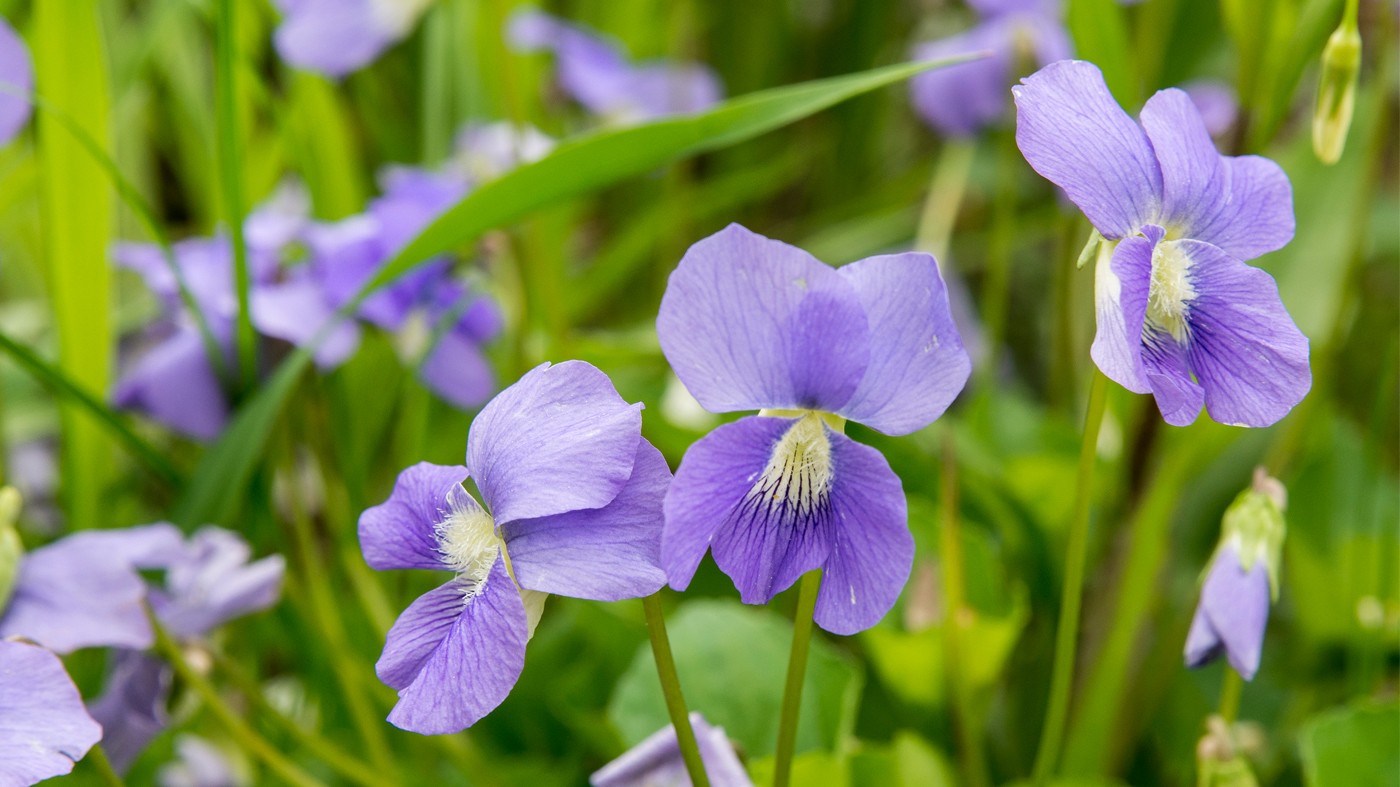

Smart Gardener
The Language of Weeds

In the Victorian-era language of flowers, a bunch of violets meant faithfulness.
In the language of lawns, it means wet soil and shade.
Weeds don't just happen at random. Different conditions favor plants that evolved in different habitats. So the particular plants that pop up where you don't want them might tell you something you didn't know about your garden.
When Tom Tiddens, supervisor of plant healthcare at the Garden, sees a tree or shrub declining, for example, he looks at the ground to see what's thriving. If he sees yellow nutsedge, he knows to check for poorly draining soil.
The nutsedge is an indicator weed, whose presence can indicate a condition that might be a problem for your chosen plants but makes the weed right at home. If you can change the conditions, or choose an ornamental plant that is more suited to them, the weeds will have a harder time competing.
Like those violets — charming in their place, but maybe not in your lawn — a weed is usually defined as any plant where you don't want it. But there are certain species, many of them introduced from the Old World, that are particularly successful at seizing opportunities in the New World, where they have few natural enemies other than people. These are the plants that gardeners and farmers collectively call weeds.
Weeds have a language, and it's useful for a gardener to understand a bit of it. Paying attention to which weeds you're pulling may help you make changes that lead to fewer weeds to pull. The presence of certain weeds is not conclusive evidence by itself, but it might prompt you to dig down and investigate or get a soil test.
"Any time you see a lot of weeds in your lawn, it's an indication you're not hitting things right," Tiddens says. Something — too much nitrogen or not enough, compacted soil, overwatering, or the wrong mix of grass species for your yard — is working better for the weeds than for the grass.
Compacted soil: If you see mats of prostrate knotweed, spotted spurge, or plantain, Tiddens says, take a shovel and check whether your soil is so packed down that grass roots can't penetrate and air and water can't reach them. Weeds that tolerate compacted soil often occur in lawns that see lots of traffic, such as back yards with kids, parks and playing fields or along paths. Having the lawn core-aerated frequently to open it up to air and water should help.
Low fertility: Clover tends to turn up in lawns that aren't getting enough nitrogen to support healthy grass. In fact, "that might be just Mother Nature trying to provide some fertility," Tiddens says. That's because clover is a legume that can actually collect nitrogen from the air and deliver it to the soil where other plants such as grass can use it. For that reason, clover seed used to be included in grass seed mixes and clover was considered a normal and desirable part of a lawn.
If clover is not to your taste or you worry about the bees that love it, providing more nitrogen — at the rate of 1 pound of actual nitrogen per 1,000 square feet a year — will help the grass grow and compete better.
High fertility: Places that have plenty of nutrients, especially nitrogen, invite different weeds. Purslane, for example, often turns up in the rich soil of perennial beds, Tiddens says. Other indicators that the soil has ample nutrients include lambs' quarters and chickweed. So don't assume that more fertilizer is always better for a lawn or garden. If you overfertilize, Tiddens says, "you're just going to make the situation worse."
Wet soil and drainage problems: Yellow nutsedge "just loves, loves, loves wet conditions," Tiddens says. Its grassy leaves tend to grow in low places where water accumulates. Moss, too, likes it moist. Bentgrass — from golf course putting greens — can be a plague in lawns with wet soil, Tiddens says; it is much less drought-tolerant than most lawn grasses, so it quickly browns out in summer.
If you have a spot where any of these plants appear often, check it out after a rain to see if the soil is saturated. Consider installing a rain garden to make the most of a low, wet spot, or at least choose plants that like their feet wet. Maybe that low place in the lawn is a good site for a river birch. Weeds that can indicate poorly draining soil, such as clay, include common chickweed and crabgrass.
Dry soil: Many weeds do better in dry soil than turf grasses or most garden plants, which is why they often sprout in droughts. But black medick and red sorrel are particular indicators.
Shade: If you've got a lot of ground ivy (a.k.a. creeping Charlie) in the lawn, it's a sign that you really don't have enough sun for grass, especially Kentucky bluegrass, to be at its best. Violets, too, congregate in shade, especially in moist soil; they are native to American woodlands and might be welcome in the shade garden.
Consider replacing grass in deep shade under trees with areas of mulch or shade-tolerant ground covers or perennials. Overseed shady areas of the lawn yearly with seed mixes labeled for shade; they will contain species that are somewhat more shade tolerant than the standard Kentucky bluegrass.
Issues with pH: Red sorrel and prostrate knotweed thrive in acid soil, but that is not widespread in the Chicago area. We're more likely to see lambs' quarters, which prefers the high pH of alkaline soils. It's a good reminder to get a soil test that will tell you what you're really dealing with.
Adding organic matter can help a bit, but it's usually futile to try to change the pH of soil over a wide area. The wiser strategy is to choose plants that thrive in the soil you have.
Tiddens, who has been fighting weeds at the Garden since 1989, says the best weapon always is knowledge. He advises gardeners not to lump weeds together, but to learn the names and individual characteristics of the ones they regularly see to choose the best defense.
For example, he says, it's easiest to beat back dandelions, which are perennials, by digging them out in the fall so the tap roots can't sprout in the spring. But that won't work with crabgrass, an annual that sprouts from seed each summer.
To identify weeds and learn the best way to fight each of them — including appropriate herbicides if applicable — bring samples into the Plant Information Service, along with photos or information about where you found the weeds growing. It's best to consult local sources for weed information, since common names vary and different tactics may be recommended in different climates.
The other fundamental advice about weeding is this: do it early and often. That hasn't been easy advice to follow this year, when a whole year's crop of weeds seemed to sprout overnight during those freakish hot days in March. But it's not too late to bear down and weed the garden clean. Then regular vigilance with an informed eye, and a short weekly session with a weeder, should keep the situation under control so you never face an overwhelming jungle.
Beth Botts is a garden writer and speaker who lives and gardens in Oak Park, Illinois.
Banner and lead story images: By Robin Carlson, Chicago Botanic Garden
Anonymous
By User: Blahedo (Own work) [CC-BY-SA-2.5], via Wikimedia Commons
By Anneli Salo (Own work (Own photo)) [CC-BY-SA-3.0], via Wikimedia Commons
By Jean-Jacques MILAN [GFDL or CC-BY-SA-3.0], via Wikimedia Commons
By Frank Vincentz (Own work) [GFDL or CC-BY-SA-3.0], via Wikimedia Commons
By Leo Michels (Own work) [CC0], via Wikimedia Commons
By José Luis Gálvez (Fotografía del autor (own work)) [CC-BY-SA-2.5], via Wikimedia Commons
By Hugo.arg (Own work) [GFDL] or CC-BY-SA-3.0-2.5-2.0-1.0], via Wikimedia Commons
By Dalgial (Own work) [CC-BY-SA-3.0], via Wikimedia Commons
By Glenobear (Own work) [Public domain], via Wikimedia Commons
By Richard Arthur Norton (1958- ) at en.wikipedia [CC-BY-2.5], from Wikimedia Commons
By User: Fornax, from Wikimedia Commons
By by Henripekka Kallio, from Wikimedia Commons
By Rasbak (Own work) [GFDL or CC-BY-SA-3.0-2.5-2.0-1.0], via Wikimedia Commons
By Robin Carlson, Chicago Botanic Garden
By Tweeber (Own work) [Public domain], via Wikimedia Commons

